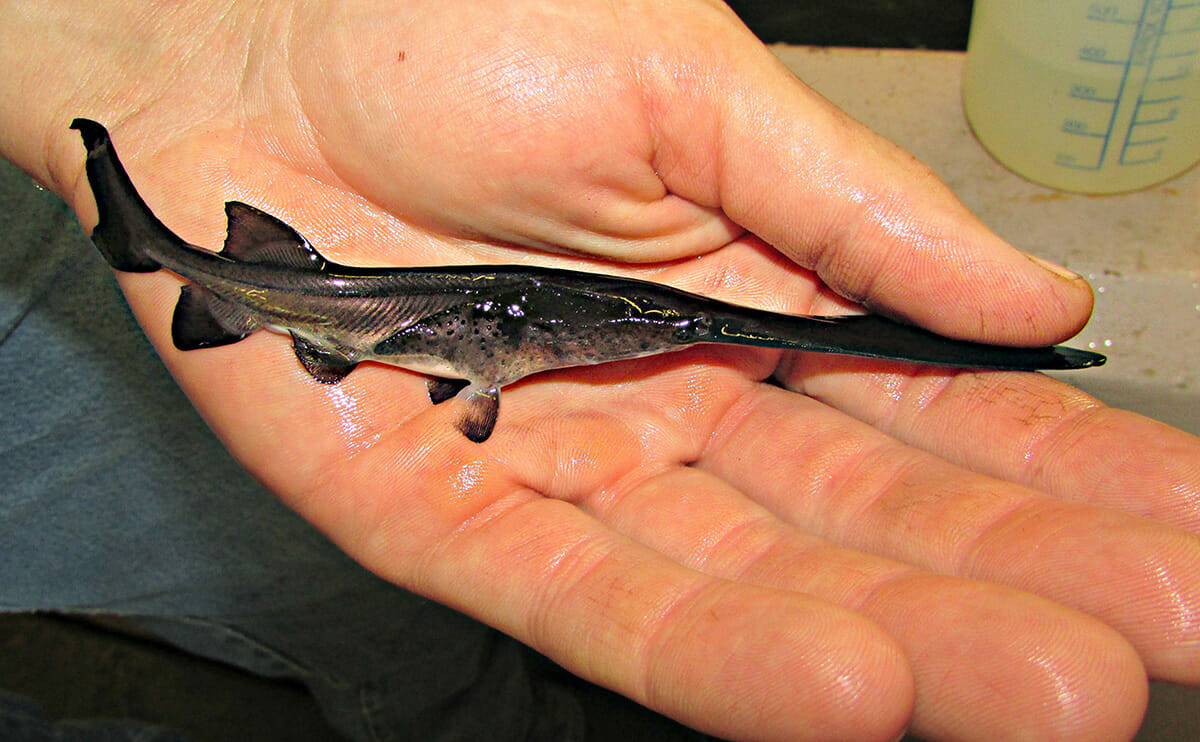Nibbling on black gold was once a delicacy only a few could afford. Only now it's paddlefish, not people, paying the price.

Last March, a two-year clandestine investigation by the U.S. Fish and Wildlife Service (U.S.F.W.) and the Missouri Department of Conservation (M.D.C.) confirmed a long-held suspicion: As sturgeon populations continue to plummet in Europe, traders and fishermen are turning to the American paddlefish to fuel the world’s love of tiny fish eggs on tiny crackers.
Caviar is a perfect wildlife product for smuggling, leading some to believe the black market is many times the size of the legal one. The tiny black beads are compact, easy to conceal, and as demand has far outpaced supply, extremely valuable.
“We knew this was coming,” Phaedra Doukakis, a sturgeon expert affiliated with the Scripps Institute of Oceanography told the Guardian. “As sturgeon stocks have been depleted around the world, we knew that paddlefish were next.”
“Depleted” almost undersells what has happened to the traditional source of high-end caviar. The beluga sturgeon population is only 1o percent what is was prior to the fall of the Soviet Union. Which means the caviar lovers are now looking in other directions — including the American Southeast.
Of the fish in the Mississippi Basin, long-nosed paddlefish are one of the biggest — capable of growing up to seven feet and weighing 160 pounds — and one of the oldest. The prehistoric-looking creature has survived the dinosaurs, but the dueling pressures of river control and fishing may force American paddlefish to follow its Chinese cousin into extinction. A wild Asian paddlefish — which can grow up to 23 feet in length — hasn’t been seen since 2005.
For the most part, paddlefish are already dependent on man for survival. Since reservoirs have drowned many natural spawning grounds, fish reproduction takes place in places like Missouri’s Blind Pony Hatchery, which the Missouri Department of Conservation uses to stock the fish around the state. Half of the 22 fish listed in the fish’s historic range list the species as endangered, threatened or of special concern.
Biologists now worry an increased demand for caviar would counteract efforts to save the fish, especially in the face of the increased popularity of paddlefish “snagging.”
When the paddlefish begin their spawning run in April and March, warm rain drives paddlefish up the Osage before they collect against Truman Dam. There, fishermen troll weighted hooks at slow speeds, watching electronic fish finders for the perfect moment to yank up on the pole. With luck, a 90-pound paddlefish is “snagged” and ends up on the other end of the line.
One man was observed by undercover agents paying $750 for seven female paddlefish, before being caught at Washington-Dulles Airport with two and a half pounds of paddlefish roe sealed in plastic containers. At $13 an ounce, roe cut from those fish could have fetched almost $30,000 in Europe.
Snaggers can legally take two fish from the reservoir and have up to four in their possession at one time, but in Missouri they may not remove eggs from a carcass, transport them or sell them.
Fear about paddlefish extinction leads to fear by fishermen fear that there may end to the sport of paddlefish snagging, which according to Chrystal Peyton, who co-authored Damming the Osage with her husband Leland, “isn’t much of a sport.”
Leland, who grew up along the Osage River and has some snagging experience, is quick to push back. “It’s kind of a blue-collar sport,” he explains. “That’s not a value judgment by any means, just to say that snagging is a down and dirty operation, not a gentleman’s sport like dry fly fishing for trout.”
But authorities say it’s not about whether the sport is high- or low-brow, but that snaggers were simply overfishing the paddlefish.
“Some people were taking three times that in one day and continuing to fish,” says Larry Yamnitz, the Missouri Department of Conservation’s Protection Chief. Others allegedly went further, either conspiring to smuggle the eggs across state lines or, in the pending case of Fedor Pakhnyuk, forming an enterprise that would sell processed caviar to Chicago markets.
It’s little mystery as to why criminals would go through the trouble — undercover agents also observed Andrew Pravosky pay $750 for seven female paddlefish before he was caught at Washington-Dulles Airport with two and a half pounds of paddlefish roe sealed in plastic containers. At $13 an ounce, roe cut from those fish could have fetched almost $30,000 in Europe.
Ironically, the survival of the ancient fish may hinge on efforts that recognize the value of paddlefish eggs rather than undercover operations to snag poachers. The Paddlefish Research Center in Miami, Oklahoma cleans and fillets paddlefish for free so long as sportsmen allow them to keep the roe. Those eggs earned the center $1.5 million dollars in 2012 which, explains Research Supervisor Brent Gordon, went to funding nighttime flyovers to stop poachers, night vision goggles and invaluable scientific insights into paddlefish breeding habits.
“The beauty of the operation is that we can use the eggs to better manage the wild population,” says Gordon.
Fish farming operations, like L’Osage Caviar in Osage, Missouri have offered a far most sustainable way to get paddlefish caviar to market, but at its heart, the threat to the fish is the human appetite for luxury.
Nibbling on black gold was once a delicacy only a few could afford. Only now it’s paddlefish, not people, paying the price.